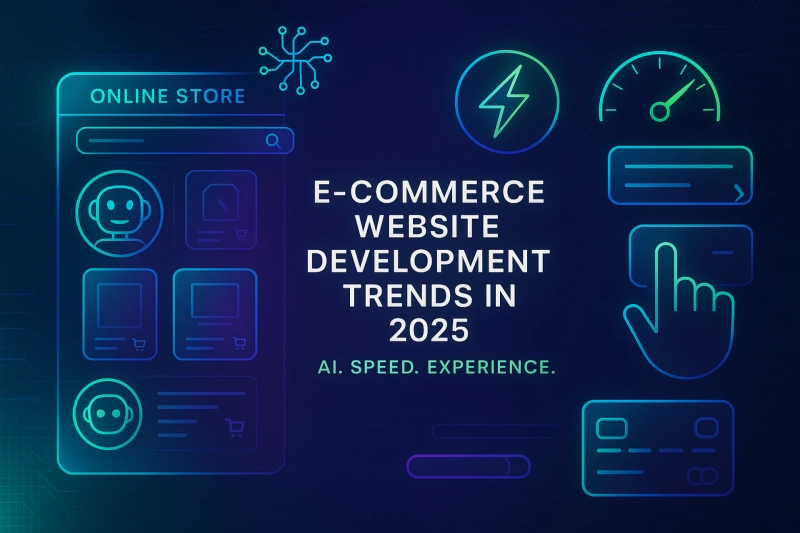The e-commerce industry continues to evolve at a rapid pace, and 2025 is shaping up to be a transformative year. Fueled by advances in artificial intelligence (AI), changing user expectations, and the growing demand for speed and personalization, e-commerce website development is experiencing a strategic shift. Brands that embrace these changes will gain a significant competitive edge in customer experience, retention, and conversion rates.
In this blog, we explore the top e-commerce web development trends in 2025, focusing on how AI, performance, and user experience (UX) are redefining the future of online shopping.
Why 2025 Is a Pivotal Year for E-Commerce Websites
Consumer behavior is changing. Shoppers now demand faster page loads, hyper-personalized recommendations, real-time support, and a frictionless checkout experience. In 2025, e-commerce website development is less about having an online catalog and more about crafting an intelligent, high-performing digital storefront that feels as personalized as a physical experience.
Key expectations from modern e-commerce platforms:
- Lightning-fast performance
- Mobile-first and responsive design
- AI-driven product discovery
- Secure and simplified payment systems
- Accessibility and inclusiveness
- Seamless omnichannel experience
Top E-Commerce Website Development Trends in 2025
1. AI-Powered Personalization
Artificial Intelligence is no longer a nice-to-have—it’s essential. In 2025, AI algorithms drive everything from product recommendations to dynamic pricing and predictive search.
Applications of AI in e-commerce:
- Personalized product carousels
- Behavioral targeting and remarketing
- Inventory forecasting and demand prediction
- Smart search with NLP (Natural Language Processing)
- AI chatbots and virtual shopping assistants
AI helps e-commerce websites deliver unique shopping experiences for each visitor, boosting engagement and conversions.
2. Headless Commerce Architecture
The rise of headless commerce allows developers to decouple the frontend from the backend, enabling more flexibility, scalability, and faster experimentation.
Benefits of headless architecture:
- Faster site speed and better SEO
- Omnichannel selling (web, app, smart devices)
- Custom UX/UI tailored to user behavior
- Easy integration with modern CMS and CRM platforms
In 2025, many e-commerce businesses are adopting platforms like Shopify Hydrogen, BigCommerce, and Strapi to power headless storefronts.
3. Ultra-Fast Page Speeds with Core Web Vitals Optimization
Speed remains a key factor in conversion rates and SEO. Google’s Core Web Vitals continue to play a major role in search ranking and user experience.
Key metrics:
- Largest Contentful Paint (LCP) < 2.5s
- First Input Delay (FID) < 100ms
- Cumulative Layout Shift (CLS) < 0.1
Techniques for speed optimization in 2025:
- Server-side rendering (SSR) with frameworks like Next.js
- Lazy loading and code splitting
- CDN delivery via platforms like Cloudflare or Netlify
- Image optimization with AVIF, WebP
4. Mobile-First Design & PWA Adoption
With over 70% of e-commerce traffic coming from mobile devices, mobile-first development is non-negotiable. Many brands are also turning their e-commerce sites into Progressive Web Apps (PWAs) for better performance and offline capabilities.
Benefits of PWAs:
- App-like experience in browsers
- Faster load times
- Offline functionality
- Push notifications for re-engagement
Mobile UX trends include thumb-friendly navigation, gesture-based controls, and biometric login options.
5. Voice Commerce and Conversational Interfaces
Voice-enabled shopping is gaining traction as users grow more comfortable interacting with AI assistants like Alexa, Siri, and Google Assistant.
Features emerging in 2025:
- Voice search integration on product pages
- Conversational product filters (e.g., “show red dresses under $50”)
- AI-powered support bots with real-time decision trees
- Voice-assisted checkout and order tracking
Voice UX is now a key differentiator for accessibility and convenience in e-commerce websites.
6. Advanced UX/UI Design and Accessibility
User expectations around usability and accessibility have never been higher. E-commerce websites must offer a consistent and intuitive user experience across devices and demographics.
UX priorities in 2025:
- Minimalist design with micro-interactions
- Dark mode toggles
- Inclusive design (ADA/WCAG compliance)
- Personalized dashboards for logged-in users
- Live product demos and 3D previews
UI toolkits like Tailwind CSS, Framer Motion, and GSAP are widely used to build rich, interactive shopping experiences.
7. Secure and Streamlined Checkout Experience
Cart abandonment remains a challenge. In 2025, optimized checkouts are all about reducing friction and offering multiple payment methods with minimal effort.
Modern features:
- One-tap checkout (Shopify, Stripe, Apple Pay)
- Express payment buttons on product pages
- Integrated buy-now-pay-later (BNPL) options
- Address autofill with Google or Apple APIs
- Two-factor authentication and tokenization
Security remains crucial, with e-commerce sites implementing SSL, PCI compliance, and real-time fraud detection tools.
8. Sustainability and Green UX
Environmental awareness is influencing how websites are designed and hosted. Shoppers are increasingly choosing brands that are transparent and sustainable.
Examples of green UX:
- Eco impact calculators in carts
- "Green shipping" filter on product listings
- Carbon-neutral hosting platforms
- Sustainable packaging badges and filters
This emerging trend not only supports environmental goals but also improves brand loyalty among younger demographics.
Best Practices for E-Commerce Website Development in 2025
- Use a modular tech stack for better scalability
- Optimize for both performance and SEO from day one
- Build with accessibility guidelines (WCAG 2.2) in mind
- Embrace mobile-first and responsive layouts
- Integrate robust analytics for behavior tracking
- Ensure fast support and live chat availability
- Keep the user at the center of every design decision
Industry Insight
According to market studies, e-commerce revenue is expected to cross $8 trillion globally by the end of 2025. Businesses that adopt cutting-edge web development practices are positioned to lead in user satisfaction, retention, and search engine visibility.
Whether selling fashion, electronics, groceries, or niche products, a smart, adaptive, and future-ready website is the foundation of digital commerce success.



